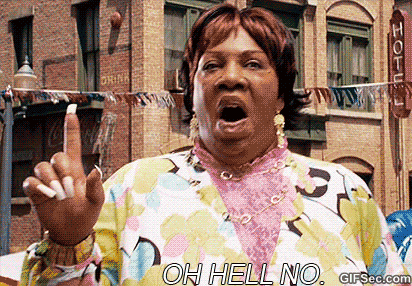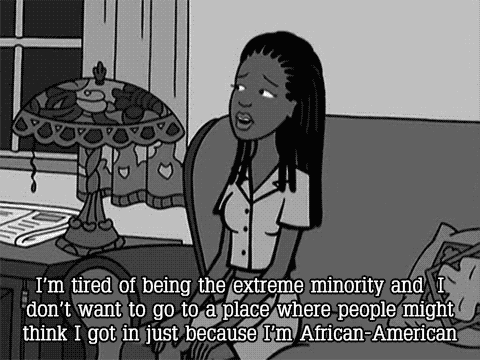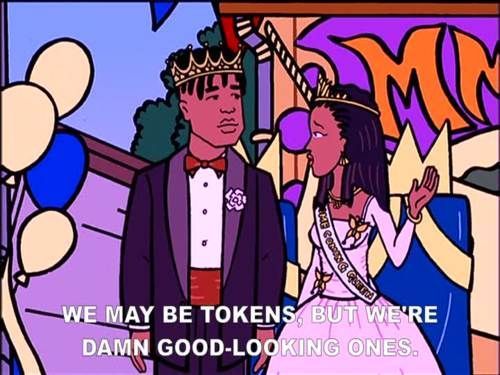
“Seeing the world through the eyes of a Blaria (a.k.a. Black Daria).” With those 12 little words, my blog began in 2012. More than expressing my musings on race, gender, and pop culture, the most important aspect of Blaria, which I didn’t realize until just now, is that it’s a nod to one of the best and most influential ‘90s feminist icons: Daria Morgendorffer. Anyone who went to Blaria instantly knew what tribe I aligned myself with, and what a tribe it was: sarcastic, droll, hyper-self-aware, and way too smart to deal with the shallow and flawed world around it. Daria was its queen.
Daria started out as a supporting cast member on Beavis and Butt-head because MTV’s president, Judy McGrath, deemed that the show should have at least one intelligent female character. That’s right, the mandate was not to have a bombshell character, or a sexy villain, or a buzzkill character who appeared only to ruin the guys’ good time. McGrath wanted something different. Something that was not only more true to real life, but representative of an underfed audience: smart teenage girls. Enter Daria, a crafty loner with wit and a wardrobe that screamed more “Doc Martens are my co-pilot” than “Hit me, baby, one more time.” Almost instantly, McGrath recognized the power and potential of her character and ordered a spinoff. Daria was one of the first of her kind on TV, but that’s not what makes her or the show special: It’s Daria’s willingness for real talk on race, gender, and identity that feels as crucial today as ever.
If the Bechdel test existed when this show was on the air, Daria would have passed with flying colors. Whether she and her best friend, Jane Lane, were waxing philosophic about being judged on their looks, or Daria and Jodie Landon (more on her later) were discussing the school dynamics at Lawndale High, plenty of the female characters spent the majority of their time not consumed with crushes on boys. Because of that, it allowed for more interesting conversation and character development, and reminded teenage girls that there is more to life than being someone’s girlfriend.
Add that to a long list of the show’s other achievements: Daria was one of the first openly atheist characters on TV; the series tackled body image in the season-five episode “Fat Like Me“; and it managed to make the popular kids (well, at least some them), like Jodie and her footballer boyfriend, Mack, multidimensional instead of dimwitted fools who are beautiful, rich, and vapid, proving that everyone has a difficult time in high school. Most important, it created a female character in Daria who isn’t pitied or forced to get a makeover to be more palatable to others. She remains true to herself and demands the same of her family and friends. While this certainly makes her a wise character, it would also make her a bland one if she never turned the microscope on herself. In what is one of my favorite scenes from the entire series, Daria breaks down the insecurities of every member of her family, including herself. Her self-awareness is not only on point but entertaining, and audiences tuned in every week to see her calling bullshit.
As much as I’m a Daria girl, though, what made the show a game-changer for me was Jodie, Daria’s black friend who escaped the “Black Friend” label because there was none of this:

There was no mm-hmming, no chile, lemme tell you, no neck-rolling. Jodie did not exist solely to provide wisdom for Daria or listen ad nauseam to Daria’s boy troubles while her own dating calendar was as empty as a metal bin following a Black Friday sale on $2 waffle-makers at Walmart. Jodie had a boyfriend, Mack, who was a football player, and the two of them were popular in a way that felt aspirational. She was philanthropic, the president of several clubs, and saw herself as a future leader for black people. And she was one of the few people of color at a predominantly white high school. As a result, she often felt pressure from others, and herself, to represent her race. Wow. Can we talk about that for a second?
A show in the ‘90s was able to understand that even though Jodie and Daria are similar in a lot of ways, they are different because of race, and as a result, Jodie has much a different view of the world, and the world has a much different view of her. That, my friends, in a nutshell, is the intersectionality experience, and the fact that Daria got it was certainly not expected at the time. It was undoubtedly welcomed by a legion of black women who watched this show. Her experience was my experience; her fears were mine:

Sure, there could’ve been more exploration into Jodie’s character. She wasn’t in the show enough for my liking, and she was rarely seen with anyone black unless it was her boyfriend. But I commend the show for being smart enough to make commentary like this …

… which is from the episode “I Loathe a Parade,” where Jodie and Mack are frustrated that they win Homecoming King and Queen every year, solely so predominantly white Lawndale High can claim it’s diverse. This is powerful stuff for a cartoon to not only cover, but cover in a way that doesn’t come off as “after-school special,” which may be why the show’s legacy has endured to this day: Its messages still resonate. And we need Daria now as much as we ever did.
There’s a whole new crop of young girls growing up in an age of Instagram hearts, Facebook likes, and Tinder swipes, and these ladies are being conditioned to think that acceptance by complete strangers is the be-all, end-all of their existence. An acceptance, mind you, that is predicated on their physical appearance. There needs to be more counterprogramming happening. Despite rumors that pop up every few years about a reboot, there are no new episodes of Daria in the works. Thankfully, the entire series is available online, so young women can continue to be inspired by Daria Morgendorffer, Jane Lane, and Jodie Landon.

